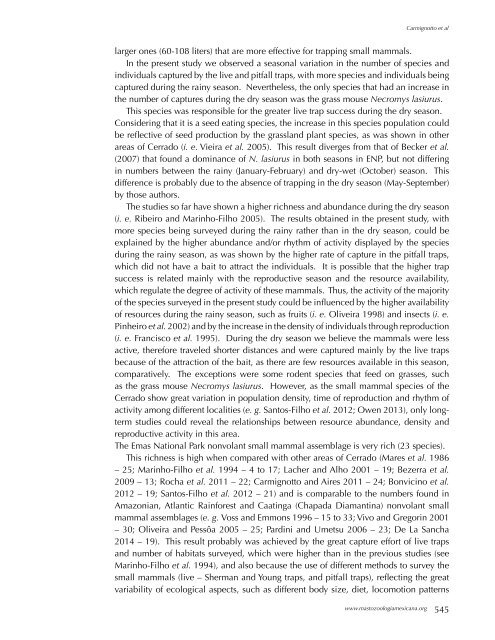therya-5_2
therya-5_2
therya-5_2
You also want an ePaper? Increase the reach of your titles
YUMPU automatically turns print PDFs into web optimized ePapers that Google loves.
Carmignotto et al<br />
larger ones (60-108 liters) that are more effective for trapping small mammals.<br />
In the present study we observed a seasonal variation in the number of species and<br />
individuals captured by the live and pitfall traps, with more species and individuals being<br />
captured during the rainy season. Nevertheless, the only species that had an increase in<br />
the number of captures during the dry season was the grass mouse Necromys lasiurus.<br />
This species was responsible for the greater live trap success during the dry season.<br />
Considering that it is a seed eating species, the increase in this species population could<br />
be reflective of seed production by the grassland plant species, as was shown in other<br />
areas of Cerrado (i. e. Vieira et al. 2005). This result diverges from that of Becker et al.<br />
(2007) that found a dominance of N. lasiurus in both seasons in ENP, but not differing<br />
in numbers between the rainy (January-February) and dry-wet (October) season. This<br />
difference is probably due to the absence of trapping in the dry season (May-September)<br />
by those authors.<br />
The studies so far have shown a higher richness and abundance during the dry season<br />
(i. e. Ribeiro and Marinho-Filho 2005). The results obtained in the present study, with<br />
more species being surveyed during the rainy rather than in the dry season, could be<br />
explained by the higher abundance and/or rhythm of activity displayed by the species<br />
during the rainy season, as was shown by the higher rate of capture in the pitfall traps,<br />
which did not have a bait to attract the individuals. It is possible that the higher trap<br />
success is related mainly with the reproductive season and the resource availability,<br />
which regulate the degree of activity of these mammals. Thus, the activity of the majority<br />
of the species surveyed in the present study could be influenced by the higher availability<br />
of resources during the rainy season, such as fruits (i. e. Oliveira 1998) and insects (i. e.<br />
Pinheiro et al. 2002) and by the increase in the density of individuals through reproduction<br />
(i. e. Francisco et al. 1995). During the dry season we believe the mammals were less<br />
active, therefore traveled shorter distances and were captured mainly by the live traps<br />
because of the attraction of the bait, as there are few resources available in this season,<br />
comparatively. The exceptions were some rodent species that feed on grasses, such<br />
as the grass mouse Necromys lasiurus. However, as the small mammal species of the<br />
Cerrado show great variation in population density, time of reproduction and rhythm of<br />
activity among different localities (e. g. Santos-Filho et al. 2012; Owen 2013), only longterm<br />
studies could reveal the relationships between resource abundance, density and<br />
reproductive activity in this area.<br />
The Emas National Park nonvolant small mammal assemblage is very rich (23 species).<br />
This richness is high when compared with other areas of Cerrado (Mares et al. 1986<br />
– 25; Marinho-Filho et al. 1994 – 4 to 17; Lacher and Alho 2001 – 19; Bezerra et al.<br />
2009 – 13; Rocha et al. 2011 – 22; Carmignotto and Aires 2011 – 24; Bonvicino et al.<br />
2012 – 19; Santos-Filho et al. 2012 – 21) and is comparable to the numbers found in<br />
Amazonian, Atlantic Rainforest and Caatinga (Chapada Diamantina) nonvolant small<br />
mammal assemblages (e. g. Voss and Emmons 1996 – 15 to 33; Vivo and Gregorin 2001<br />
– 30; Oliveira and Pessôa 2005 – 25; Pardini and Umetsu 2006 – 23; De La Sancha<br />
2014 – 19). This result probably was achieved by the great capture effort of live traps<br />
and number of habitats surveyed, which were higher than in the previous studies (see<br />
Marinho-Filho et al. 1994), and also because the use of different methods to survey the<br />
small mammals (live – Sherman and Young traps, and pitfall traps), reflecting the great<br />
variability of ecological aspects, such as different body size, diet, locomotion patterns<br />
www.mastozoologiamexicana.org<br />
545



